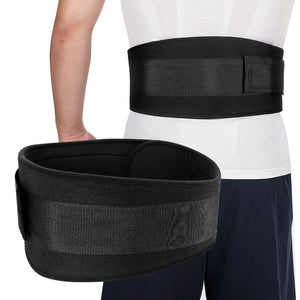Knee Brace for Torn Ligaments: How to Treat MCL, ACL, PCL, and LCL Injury

Torn knee ligaments, especially the ACL, can happen at any time due to sudden twisting and overstretching of the ACL. This makes it difficult for you to undertake routine activities such as walking, running and climbing stairs at all. According to the National Library of Medicine, around 1 in 3500 people in the US[1] experience ACL injury in their lifetime, requiring the usage of a knee brace for torn MCL, ACL, and PCL.
Want to know more? This article is your complete guide to knee ligament injuries, their types, and the best knee brace for torn MCL or ACL. Let's dig in!

Types of Knee Ligaments
Knee ligaments are typically a band of tissues responsible for joining your thigh bone in your upper leg to your lower leg bones. They are made of:
- College
- Elastic fibre
- Connective tissues
These ligaments are classified into four categories, each responsible for a specific task.
ACL (Anterior Cruciate Ligament)
The anterior cruciate ligament connects the inside of the top of your tibia, also known as the shinbone, with the bottom of your knee or thigh bone. This ligament takes on the task of ensuring your shinbone doesn't slip or slide in front of your thigh bone, hence controlling knee rotation.
Injury to the ACL can happen as a result of twisting the leg while applying pressure downward. You'll experience swelling of the knee as well as some instability that will go away either with physical therapy for ACL tear or a brace for ACL tear.
PCL (Posterior Cruciate Ligament)
The next important ligament is PCL or posterior cruciate ligament. Known as the strongest and largest intra-articular ligament in the human knee, it connects the bottom of your thigh bone with the top of your lower leg bone.
It's located inside your knee and is very unlikely to sustain injury. Nonetheless, any damage to the posterior cruciate ligament can happen due to extra stretching, which is called an overextended knee.
MCL (Medial Collateral Ligament)
The medial collateral ligament is also located inside the knee and it is eight to ten centimeters in length of the knee to which it attaches. It attaches the top of the tibia to the bottom of the thigh bone or femur and supplies extreme stability to the knee.
This ligament injury is quite common and accounts for 40% of all knee injuries.[2] Generally, MCL tears are divided into three grades. Grade 1 means you'll have mild pain and tenderness, and Grade 2 translates to your MCL being partially torn.
You'll feel intense pain and tenderness, and the knee will feel loose when moved by hand. However, a grade 3 tear is a severe tear, i.e., a complete tear of the MCL, and requires a knee brace for the torn MCL.
LCL (Lateral Collateral Ligament)
An important fourth knee ligament is the lateral collateral joint ligament. It is a cord-like band of ligaments on the outside of the knee that attaches the lower part of the base of the thigh bone to the upper part of the calf bone at the upper part of the leg.
This ligament can also tear, which can result in such problems as swelling and bruising. However, with proper rehab and a good knee brace for a torn MCL or torn LCL, recovery will be fast and good.
Causes of Ligament Injuries
Knee ligament injuries are caused by a variety of factors that include:
- Sudden Twists and Turns: Turning and changing directions quickly, especially in games such as rugby, soccer and basketball, can pull knee ligaments and lead to tears at the knee.
- Direct Impact: A direct blow or hit to any of your knee ligaments, including LCL, PCL, ACL, or MCL, from a collision can result in knee ligament injury.
- Overextension: Over-extension or extension of ligaments during sports, hopping, or other entertainment opportunities is another cause of knee ligament injuries.
- Trauma: Ligament tears in the knee can also be the result of a traumatic injury, such as a car crash, where the knee can take a sudden impact.
Symptoms of Ligament Injuries and How to Diagnose Them
Well, the signs of a torn ACL, MCL, LCL, or PCL can vary depending upon the severity and specific ligament involved, but common signs include:
- Pain: Immediate and severe knee pain on the site of tear.
- Swelling: The knee is rapidly red and swollen as a result of internal bleeding and inflammation.
- Limited Range of Motion: It is difficult to move the knee joint on account of pain and swelling.
- Popping Sound: Noticeable “popping” sounds, which may strike at the moment of injury, are common in Grade 3 sprains.
- Tenderness: Sensitivity to feel around the injured area.
You may also feel laxity, bruising, and an inability to bear weight in your knee, all symptoms of a torn knee ligament.

Diagnosis of Knee Ligament Injuries
Diagnosing a knee ligament injury and whether you need a knee brace for torn MCL, ACL, PCL, or LCL is a combination of many steps. Let's discuss them!
- Medical History: The doctor will first examine your knee carefully and ask questions about the circumstances of the injury. You'll also be required to tell the symptoms you are experiencing.
- Physical Examination: A physical evaluation includes the doctor appraising the knee and the identifying areas of bruising and pain. They may also verify range of motion by averting the knee in alternate orientations by moving it in different directions over time. In some cases, if the knee is swollen due to internal hemorrhaging, the doctor may use needles to direct the bleeding of the knee.
- Imaging Tests: Next, your doctor will order the following imaging tests:
- X-ray: This will reveal the site of the tear and the doctor may also find a fracture or infection.
- MRI: Detailed images of knee tissues and ligaments are available to help doctors realize the extent of torn knee ligaments.
What People Are Vulnerable to Ligament Injuries?
Here are the people who are most vulnerable to knee ligament tears and may require a knee brace for torn MCL:
- Athletes: People who compete in high-impact sports such as football, basketball, skiing and gymnastics are at a heightened risk of getting torn knee ligaments on their knees at the time of the accident. This is because rapid changes of direction and jumping place enormous stress on the knee joint.
- Older People: People over 40 are also prone to knee ligament tears because their ligaments become elastic and they suffer from pre-existing conditions such as knee arthritis or osteoarthritis.
Treatments for Knee Ligament Injuries
The treatment plans for knee ligament injuries are different for each individual. However, some common things that can help you are:
- Apply ice on the affected knee area to reduce swelling and pain.
- Resting the knee is crucial so that torn ligaments can heal, so it is imperative that you rest for at least 6 weeks before reverting to your standard activities of activity.
- Use anti-inflammatory tablets such as ibuprofen which are suggested by your doctor to soothe the pain from the discomfort.
- Treat an MCL or ACL tear with a knee brace because it provides support and stability for your knee. In this case, a Fivali Knee Brace (such as the Fivali Running Compression Knee Brace with Patella Gel Pad and Lateral Stabiliser) is an incredible option.
It's a stretchy compression knee brace for torn MCL with spring knee support technology that quickly helps heal your ligament tear.
If the tear is severe, these general treatment tips may not work, and you may have to undergo surgery. So, always consult your doctor and follow the approach to treatment that is best suited to your circumstances of injury as well.

Torn knee ligaments can bring pain to patients if not properly taken care of. So when you suffer a ligament tear, choose a top quality knee brace for MCL and ACL tears as soon as possible to give your knee the support it needs. Fivali supplies a range of high quality knee pads designed to aid recovery. Discover the perfect knee brace for you by contacting us today and start your journey to recovery!













